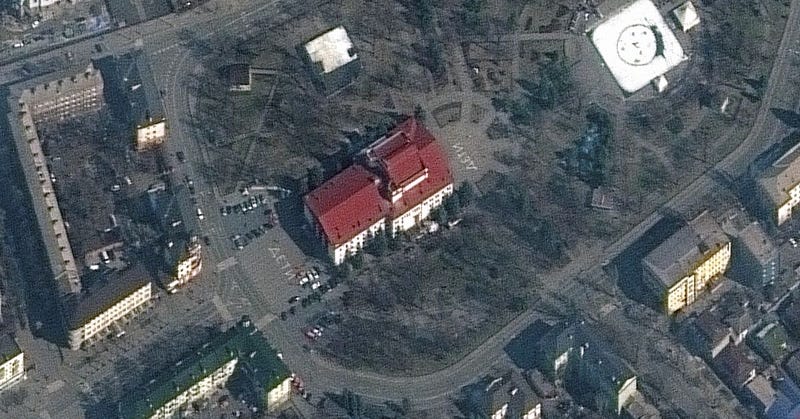Russia Intentionally Bombs Theater in Mariupol Sheltering Civilians

Today, people are reacting to the news that Russia dropped a massive bomb on a theater in Mariupol. The theater was sheltering civilians in the city besieged by Russian forces. After the bombing, a US satellite provider showed that before the tragedy, there were signs on the ground that warned in Russian to pilots that children were in the theater and not to bomb it. We now know this bombing was an intentional terror attack by Russia. During the Syrian civil war, Russia often targeted civilian infrastructure with airstrikes to terrify them into submission. However, Russia denies that the theater was a target for their pilots and instead claims that Nazis dropped a bomb on it.
This horrific tragedy reminds me of a hostage crisis in Moscow twenty years ago and how the Russian government decided that it was necessary to kill a number of the hostages, along with the terrorists, to resolve the situation. Forty Chechen terrorists took 850 hostages at the Dubrovka Theater in Moscow. The Chechens, angry at Russia for destroying their homeland, wanted to bring the war back to Moscow. They also wanted Chechnya to become independent and for Russian troops to withdraw.
How did Russian authorities, under the control of Vladimir Putin, respond to this crisis? First, he had the Spetsnaz (Russian special forces) pump a chemical agent into the ventilation system of the building, and then they stormed it. As a result, one hundred and seventy-one hostages died, along with 40 of the Chechen terrorists. In addition, seven hundred hostages had to deal with chronic health problems for the rest of their lives due to the effects of the poison gas.
So I think there might be a good reason why NATO is still around. And the devastation that Russia left behind in Chechnya was not because NATO “forced” them to do it. Also, at the end of the last century, Russia supported Yugoslavian President Slobodan Milošević in his genocides against the Muslim populations of Bosnia and Kosovo.
Citations
Abstract: After years of propping up President Bashar al-Assad in Syria, experts say Russia is using the same playbook in Ukraine.
Abstract: On October 23, 2002, about 50 Chechen rebels storm a Moscow theater, taking up to 800 people hostage during a sold-out performance of a popular musical.
Abstract: Ten years ago, Russia and the world held their breath as special forces surrounded a Moscow theatre where nearly 1,000 people were being held hostage. The siege ended in tragedy, and still provokes recriminations.
Abstract: SHANGHAI (AP) — Early one morning in October 2002, a dense white cloud silently filled Moscow’s Dubrovka Theater. It had been three days since Chechen militants took more than 800 people hostage. Russian special forces faced an impossible task: liberating the hostages from a theater laced with booby traps and several dozen suicide bombers. They turned to chemicals Russian scientists had been researching for years, and pumped an aerosol containing potent forms of the synthetic opioid fentanyl into the theater before storming it.
Abstract: The Moscow theater hostage crisis (also known as the 2002 Nord-Ost siege) was the seizure of the crowded Dubrovka Theater by 40 to 50 armed Chechen terrorists on 23 October 2002, which involved 850 hostages and ended with the death of at least 170 people. The attackers, led by Movsar Barayev, claimed allegiance to the Islamist separatist movement in Chechnya. They demanded the withdrawal of Russian forces from Chechnya and an end to the Second Chechen War. Due to the layout of the theater, special forces would have had to fight through 30 metres (100 ft) of corridor and advance up a well-defended staircase before they could reach the hall in which the hostages were held. The attackers had numerous explosives, with the most powerful in the center of the auditorium. Spetsnaz operators from Federal Security Service (FSB) Alpha and Vympel, supported by a Russian Ministry of Internal Affairs (MVD) SOBR unit, pumped an undisclosed chemical agent into the building’s ventilation system and began the rescue operation.All 40 of the insurgents were killed, and up to 130 hostages died during the siege, including 9 foreigners, due to the toxic substance pumped into the theater. The identity of the gas was never disclosed, although it was believed by some to have been a fentanyl derivative, such as carfentanil. A study published in 2012 concluded that it had been a mixture of carfentanil and remifentanyl.
Abstract: Russian forces dropped a powerful bomb on a theatre in the encircled Ukrainian port city of Mariupol where hundreds of civilians were sheltering on Wednesday, Ukraine’s foreign ministry said.
Originally published at https://michaelbakshi.com on March 16, 2022.